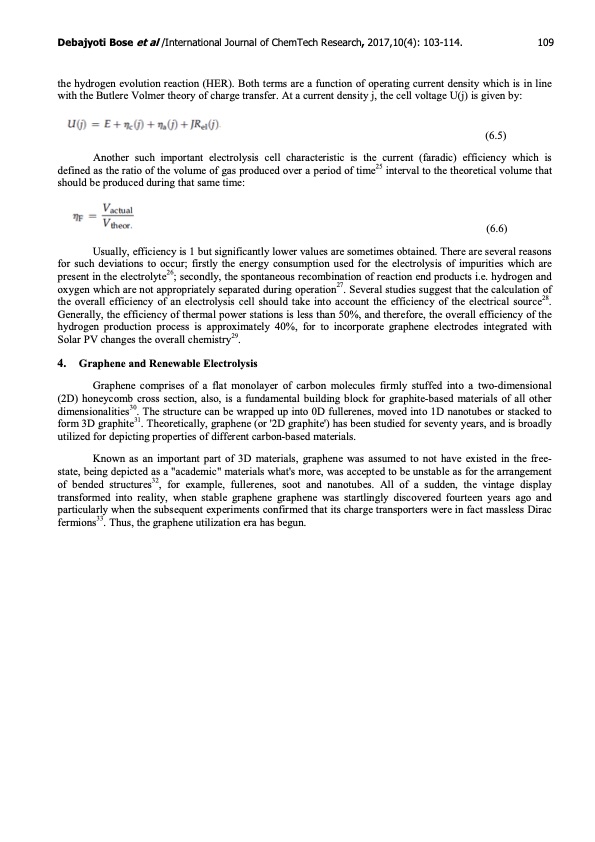
PDF Publication Title:
Text from PDF Page: 007
Debajyoti Bose et al /International Journal of ChemTech Research, 2017,10(4): 103-114. 109 the hydrogen evolution reaction (HER). Both terms are a function of operating current density which is in line with the Butlere Volmer theory of charge transfer. At a current density j, the cell voltage U(j) is given by: (6.5) Another such important electrolysis cell characteristic is the current (faradic) efficiency which is defined as the ratio of the volume of gas produced over a period of time25 interval to the theoretical volume that should be produced during that same time: (6.6) Usually, efficiency is 1 but significantly lower values are sometimes obtained. There are several reasons for such deviations to occur; firstly the energy consumption used for the electrolysis of impurities which are present in the electrolyte26; secondly, the spontaneous recombination of reaction end products i.e. hydrogen and oxygen which are not appropriately separated during operation27. Several studies suggest that the calculation of the overall efficiency of an electrolysis cell should take into account the efficiency of the electrical source28. Generally, the efficiency of thermal power stations is less than 50%, and therefore, the overall efficiency of the hydrogen production process is approximately 40%, for to incorporate graphene electrodes integrated with Solar PV changes the overall chemistry29. 4. Graphene and Renewable Electrolysis Graphene comprises of a flat monolayer of carbon molecules firmly stuffed into a two-dimensional (2D) honeycomb cross section, also, is a fundamental building block for graphite-based materials of all other dimensionalities30. The structure can be wrapped up into 0D fullerenes, moved into 1D nanotubes or stacked to form 3D graphite31. Theoretically, graphene (or '2D graphite') has been studied for seventy years, and is broadly utilized for depicting properties of different carbon-based materials. Known as an important part of 3D materials, graphene was assumed to not have existed in the free- state, being depicted as a "academic" materials what's more, was accepted to be unstable as for the arrangement of bended structures32, for example, fullerenes, soot and nanotubes. All of a sudden, the vintage display transformed into reality, when stable graphene graphene was startlingly discovered fourteen years ago and particularly when the subsequent experiments confirmed that its charge transporters were in fact massless Dirac fermions33. Thus, the graphene utilization era has begun.PDF Image | Renewable Electrolysis using Graphene electrodes

PDF Search Title:
Renewable Electrolysis using Graphene electrodesOriginal File Name Searched:
V10N4CT.pdfDIY PDF Search: Google It | Yahoo | Bing
Salgenx Redox Flow Battery Technology: Power up your energy storage game with Salgenx Salt Water Battery. With its advanced technology, the flow battery provides reliable, scalable, and sustainable energy storage for utility-scale projects. Upgrade to a Salgenx flow battery today and take control of your energy future.
| CONTACT TEL: 608-238-6001 Email: greg@infinityturbine.com | RSS | AMP |